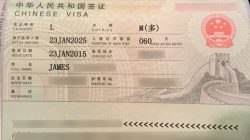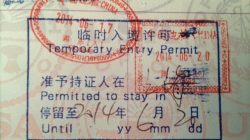So you want to visit China without a visa? You’re in luck. As of January 1, 2016, China has allowed foreigners to travel to and visit several cities in China without a formal visa for up to 144 hours, or six days.
The so-called “Transit Without Visa” (TWOV) policy provides a transit pass that allows travelers to pass through Chinese immigration and leave the airport without going through the hassle of applying for a visa before their trip. However, TWOV comes with many restrictions and conditions, including registering with the local police. (Many hotels will complete the registration for you.) If you are planning to travel within China, or if you plan to visit China more than once, it might be better to apply for a standard tourist visa. China now offers 10-year visas for multiple entries to citizens from the United States and elsewhere.
You can use TWOV as a tourist as long as you don’t stay too long and you arrange your flights in a specific way so you don’t fly directly back the way you came. But you can’t easily use TWOV to visit multiple cities within China or to enter and exit through different ports.
Follow along as I explain the details of visa-free travel to China and how to determine if your itinerary is eligible.
Eligible Nationalities
First step: determine if you are eligible to request entry to China under TWOV policies. You must hold a passport from one of these countries:
- Albania
- Argentina
- Australia
- Brazil
- Canada
- Chile
- European Union
- Iceland
- Japan
- Mexico
- Monaco
- Montenegro
- New Zealand
- North Macedonia
- Qatar
- Russia
- South Korea
- Switzerland
- Ukraine
- United Kingdom
- United States
Ports of Entry
Second, you must be entering one of these ports of entry. Entering the same region through another port of entry, such as a different airport, may not be allowed.
For a 72-hour Stay:
- Changsha Huanghua International Airport
- Chongquing Jiangbei International Airport
- Guilin Liangjiang International Airport
- Harbin Taiping International Airport
- Xi’an Xianyang International Airport
For a 144-hour Stay:
- Beijing Capital International Airport
- Beijing West railway station (when traveling on the Beijing-Kowloon Through Train)
- Chengdu Shuangliu International Airport
- Dalian Zhoushuizi International Airport
- Guangzhou Baiyun International Airport
- Hangzhou Xiaoshan International Airport
- Jieyang Chaoshan International Airport
- Kunming Changshui International Airport
- Nanjing Lukou International Airport
- Qinhuangdao Sea Port
- Qingdao Liuting International Airport
- Qingdao Sea Port
- Shanghai Hongqiao International Airport
- Shanghai Port International Cruise Terminal
- Shanghai Pudong International Airprot
- Shanghai railway station (when traveling on the Shanghai-Kowloon Through Train)
- Shanghai Wusongkou International Cruise Terminal
- Shenyang Taoxian International Airport
- Shenzhen Bao’an International Airport
- Shijiazhuang Zhengding International Airport
- Tianjin Binhai International Airport
- Tianjin International Cruise Home Port
- Wuhan Tianhe International Airport
- Xiamen Gaoqi International Airport
- Xiamen Sea Port
If you don’t see your port of entry listed above, many others will allow a 24-hour transit without visa. The shorter transit rules aren’t discussed in detail here, but in general they are more flexible and allow you to take domestic flights within China as long as you leave the country within 24 hours of your first point of entry. Obviously, that doesn’t give you much time to explore the city outside.
When Does the Clock Start?
If you’re trying to maximize your time in China, the clock starts at midnight of the day following your arrival. For example, arriving at any time on December 31, the clock will start at midnight on January 1. That means December 31 is just extra “free” time. You have either 72 or 144 hours, which means you must leave by 23:59 (11:59 PM) on January 3 for a 72-hour transit pass or on January 6 for a 144-hour transit pass.
Travel Requirements to/from China
Remember that the name of this policy is “Transit Without Visa.” It’s designed to allow you to transit China while traveling from one country to another. It is not designed for travelers who make China their primary destination.
You can still get away with this if you have a clever routing, but it helps to understand the policy’s intent. You must be traveling from one country to another country with China in the middle. How do Chinese immigration authorities interpret this? They don’t care where you began your trip or where you end it. They only care about the countries IMMEDIATELY before and after China. Here are two examples:
- If you fly from Los Angeles to Tokyo and then from Tokyo to Shanghai, the country you are arriving from is Japan, not the United States. This is true even if you only spent an hour in Japan to change flights.
- If you return by flying from Shanghai to Vancouver and then from Vancouver to Los Angeles, the country you are departing to is Canada, not the United States.
As you can see, a traveler who lives in Los Angeles can easily take advantage of TWOV by taking a different route each way. Chinese immigration authorities would view this person as transiting China while traveling from Japan to Canada even though the trip starts and ends in the United States. He or she could even fly non-stop on the way home because the outbound journey connected in a different country.
Finally, for the purposes of Chinese immigration, Hong Kong and Macau count as different countries. This means you can fly from Hong Kong to Shanghai and then to Macau and take advantage of TWOV during your stay in Shanghai. Hong Kong and Macau already offer visa-free entry to many nationalities.
Ticketing Requirements
You can successfully use TWOV when you purchase separate tickets for your inbound and outbound journey. You might do this when you have award travel and book separate awards each way. However, it is your responsibility to make sure the itinerary falls within the rules. Print copies of all your ticket confirmation receipts and carry them with you to share with the airline and Chinese immigration authorities.
The airline that checks you in for travel to China will check to make sure you are eligible for entry. They will likely reject you when they see you do not have a visa and your ticket ends in China. Ask the agent to look up the rules for Transit Without Visa.
The TIMATIC database that agents use has lots and lots of rules, and the TWOV policy is buried near the bottom. There is another policy that allows only 24 hours with fewer restrictions. The agent needs to scroll past this to find the more generous policy allowing 72 or 144 hours. You can look up the TIMATIC rules yourself if you have access to a tool like ExpertFlyer; print a copy to share with the agent and leave plenty of time at check-in just in case they are confused and try to argue.
Do not attempt to book an eligible itinerary and then change it once you arrive in China in order to circumvent the rules. Your mischief will be discovered as you return home, and you’ll be placed on a 5-year ban (see below) from re-entering the country.
Travel Requirements within China
Once in China, you cannot travel to other cities except in very limited circumstances. All visitors must arrive and depart by air, with one exception.
- Visitors to Shanghai, Jiangsu (Nanjing), or Zhejiang (Hangzhou) may travel between these three cities.
- Visitors to Changsha may travel anywhere within Hunan province.
- Visitors to Guangzhou may travel anywhere within Guangdong province.
- Visitors to Xiamen may travel anywhere within Fujian province.
- Visitors to any other destination must stay within the city limits.
In addition, visitors to Shanghai have the option to arrive by air, rail, or sea. New rules allow you to enter through one port, such as an airport, and leave by another, such as a cruise ship. Refer to the list of allowed ports earlier in this article.
Other Restrictions
Don’t try to get clever and break the rules. China is a friendly place, but you are a guest and should not attempt to deceive the authorities. It can make you ineligible for future trips to China. The TWOV policy excludes people who meet any of these conditions:
- Travel documents (i.e., passport) are valid for less than 3 months at the time of entry.
- Chinese visa refusal stamps are present in the passport.
- Violations of Chinese immigration law, including TWOV rules, in the last 5 years.
- Failing to register with the local Public Security Bureau in the first 24 hours of entry. (Most hotels do this for you.)
- Crew members and their accompanying family.
Chinese immigration authorities may also refuse to grant a waiver to people they view as suspicious for any reason. For example, they may not wish to process the paperwork for a passenger who only wants to spend a couple hours in the city to get lunch. Stamps in your passport from certain countries known for harboring terrorists or with poor diplomatic relations could also be a red flag.
If in doubt, please ask! However, I hope this updated post answers most of your questions and helps explain this unique policy for entering China without a visa.





